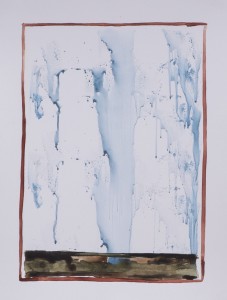To have a sense of character, one has to spend some time observing and experiencing. We make decisions on character based on what we see, sometimes quickly, sometimes considerably. When someone then does something “out of character,” we state our surprise according to a prior set of expectations, coming out of some kind of history. Shift to the realm of ideas. When it comes to knowing or recognizing what is good and what is truly evil, it seems to me that we have lost our way. We have given up caring to know. Discernment is hard to find in a culture which denigrates any reflective judgement.
I decided to name these two pieces (last post and this image). “The Nature of Evil” and “The Nature of Good” because of their complete contrast in visual character. These two serve as a primer, using symbolic imagery to introduce the notion that there are two material poles: one is good, the other is fearfully evil. And if this reality is even remotely true, being alert to the character of these poles would be a significant pursuit.
 The first image, that of evil, called Abaddon, is dominant and encroaching, seemingly boundless and fearful. The second image is much quieter, gentle but life-giving, boundaried but free. It penetrates the ground rather than taking it over. And it is rimmed by this mysteriously fragile red enclosure. When I made this second image it was after studying some illuminated manuscripts from a book a friend had given me. The first image, as I wrote earlier, took over when I made it, surprised me, troubled me. But it seemed necessary to consider. This second image was planned more carefully, but its making also involved some serendipity. I used a brayer to lay down the veils of blue watercolor, loving the delicate surprise in the markings that resulted, and that were still “in character” with the quiet beauty of good.
The first image, that of evil, called Abaddon, is dominant and encroaching, seemingly boundless and fearful. The second image is much quieter, gentle but life-giving, boundaried but free. It penetrates the ground rather than taking it over. And it is rimmed by this mysteriously fragile red enclosure. When I made this second image it was after studying some illuminated manuscripts from a book a friend had given me. The first image, as I wrote earlier, took over when I made it, surprised me, troubled me. But it seemed necessary to consider. This second image was planned more carefully, but its making also involved some serendipity. I used a brayer to lay down the veils of blue watercolor, loving the delicate surprise in the markings that resulted, and that were still “in character” with the quiet beauty of good.
This from Art & Fear, p.103 “What Science bears witness to experimentally, art has always known intuitively–that there is an innate rightness to the recurring forms of nature.” If you are able, please come see these pieces along with work from several other fine artisans at the Reece Museum on campus of East TN State, until September 12th, 2014.